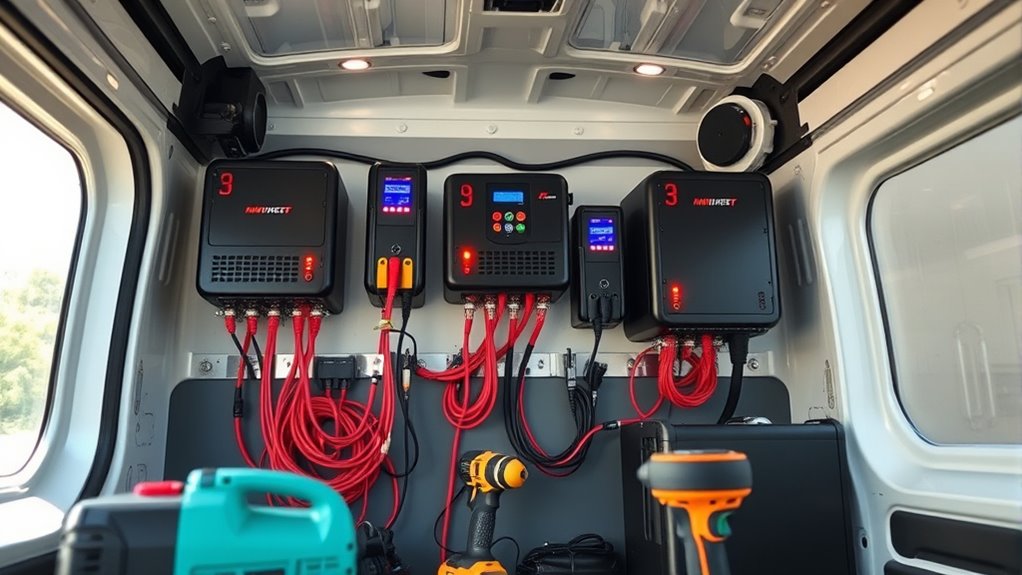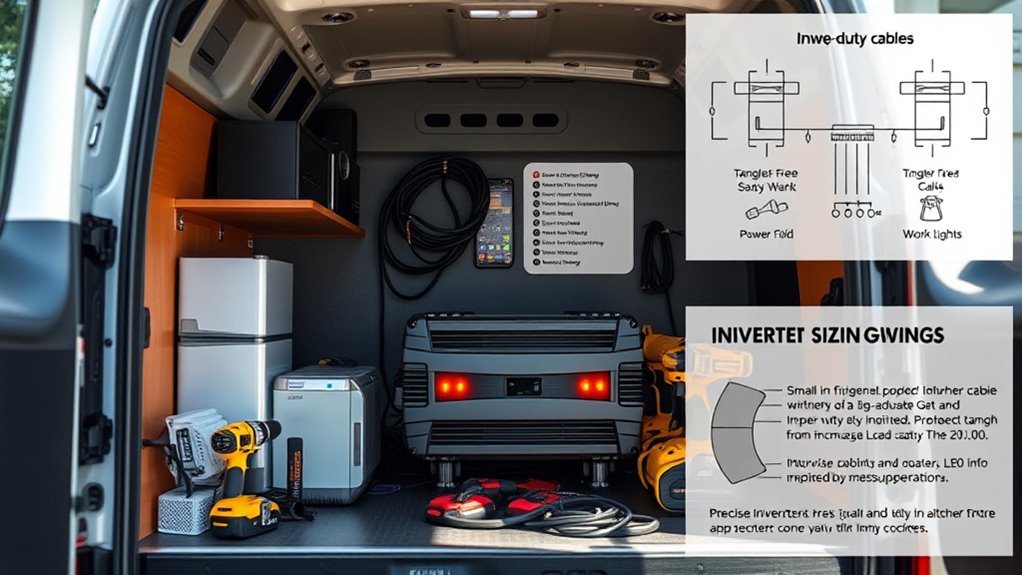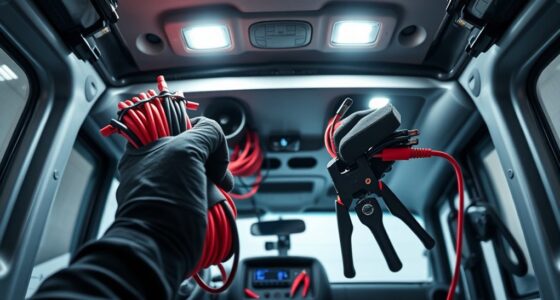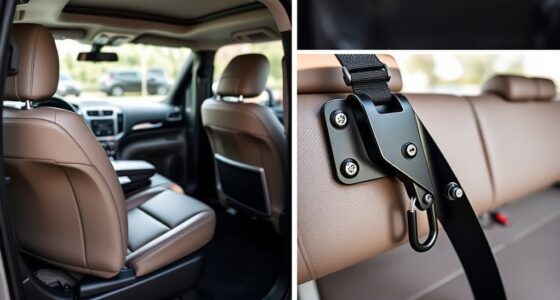To size an inverter for tools and appliances in a transit, list all your devices and check their wattage ratings. Add them together and include a safety margin of 20-25% to handle startup surges and future needs. Make sure the inverter’s continuous and surge capacities match or exceed your total load. Also, choose a model compatible with your vehicle’s 12V or 24V system, ensuring safe, reliable power for your equipment. If you keep exploring, you’ll find how to optimize your setup even further.
Key Takeaways
- List all tools and appliances to determine total wattage, including startup surges.
- Add a 20-25% safety margin to handle unexpected loads and future expansion.
- Choose a pure sine wave inverter for sensitive electronics; modified sine wave suffices for basic tools.
- Ensure the inverter’s surge capacity exceeds the startup wattage of motorized tools.
- Match the inverter’s voltage and capacity with your vehicle’s system for safe, reliable operation.

Choosing the right inverter size is vital when powering tools and appliances in a transit vehicle. If you underestimate it, you risk constantly tripping circuits, damaging your equipment, or experiencing interruptions that could delay your work. Overestimating, on the other hand, means you’ll likely spend more money than necessary and may introduce inefficiencies into your system.
To find the perfect balance, you need to understand your power requirements thoroughly. Start by listing all the tools and appliances you plan to run simultaneously. Check their wattage ratings, which are usually printed on labels or in user manuals. For example, a small refrigerator might draw around 150 watts, while a power drill could need 500 watts or more during use.
Add up these wattages to determine your total continuous load, but don’t forget to include startup surges. Many appliances, especially motors and compressors, draw considerably more power momentarily when they turn on—sometimes two to three times their running wattage.
Once you’ve calculated your total power needs, add a margin of safety—around 20-25%—to account for unexpected surges or future additions. This buffer ensures your inverter can handle sudden spikes without shutting down or causing damage. For instance, if your combined load is 1,000 watts, choosing an inverter rated at around 1,200 to 1,250 watts offers a comfortable cushion.
Remember that not all inverters are created equal; some are pure sine wave, others modified sine wave. Pure sine wave inverters produce cleaner power, which is better for sensitive electronics like laptops or medical devices, but they tend to be more expensive. Modified sine wave inverters are more affordable and suitable for simpler tools, yet they might cause noise or reduced efficiency in some appliances.
Another important factor is the inverter’s surge capacity. Even if your tools have a modest running wattage, they might need a higher surge wattage to start. Always check the surge ratings and ensure the inverter can handle these brief power spikes.
Additionally, consider your vehicle’s power source—whether it’s a 12V or 24V system—and select an inverter compatible with that voltage. Proper wiring and a reliable battery connection are fundamental for safety and performance.
Furthermore, understanding the contrast ratio of your home cinema projector can significantly improve your viewing experience by providing deeper blacks and brighter whites, which enhances image clarity and detail. Properly calculating your power needs and selecting the right inverter will ensure your transit vehicle is equipped to handle all your tools and appliances efficiently.
Frequently Asked Questions
How Do I Determine the Right Inverter Size for My Specific Tools?
To determine the right inverter size for your tools, first list all the tools you’ll run simultaneously. Check each tool’s wattage on their labels or manuals. Add up the wattages to find the total power draw.
Then, choose an inverter with at least 20-25% more capacity than this total to guarantee reliable operation and avoid overload. This way, your inverter can handle peak startup currents and future additions.
Can I Run Multiple High-Wattage Appliances Simultaneously?
Yes, you can run multiple high-wattage appliances simultaneously if your inverter has enough capacity. Typically, a 3000-watt inverter can handle several devices at once, but always verify the combined wattage.
For example, running a 1500-watt microwave and a 1000-watt blender together requires at least a 2500-watt inverter. Overloading can cause shutdowns or damage, so make certain your inverter’s continuous power rating exceeds your total appliance wattage.
What Safety Precautions Should I Take When Installing an Inverter?
When installing an inverter, you should always wear protective gear like gloves and eye protection.
Make sure to disconnect the vehicle’s battery before starting.
Use the correct gauge wiring to handle the inverter’s current, and securely connect all terminals to prevent loose connections.
Avoid installing the inverter near flammable materials.
Double-check all connections for safety.
Finally, consult a professional if you’re unsure about any step.
How Does Inverter Efficiency Impact Battery Life?
Imagine your battery is a marathon runner—efficient in conserving energy, it goes further.
When your inverter is highly efficient, it wastes less power as heat, meaning your battery lasts longer.
Conversely, a less efficient inverter drains your battery faster, forcing you to recharge more often.
Are There Portable Inverters Suitable for Temporary Tool Use?
Yes, you can find portable inverters suitable for temporary tool use. These inverters are compact, lightweight, and designed for easy transport, making them perfect for quick jobs or on-the-go tasks.
Look for models with sufficient wattage capacity to power your tools and verify they’ve safety features like overload protection.
With the right portable inverter, you can conveniently run your tools anywhere without needing a permanent power setup.
Conclusion
Choosing the right inverter is like fitting the perfect key into a lock—you want it to match precisely. When sizing your inverter correctly for tools and appliances in a transit, you’ll guarantee everything runs smoothly without overloading or damage. Remember, a well-matched inverter acts like a reliable engine, powering your devices seamlessly. Take your time to calculate your needs carefully, and you’ll keep your transit running efficiently, just like a well-oiled machine.








